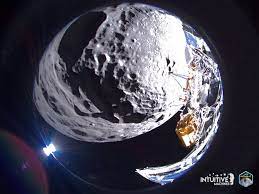
A spacecraft crafted and operated by Texas-based company Intuitive Machines successfully landed near the moon’s south pole on Thursday, marking the first U.S. touchdown on the lunar surface in over half a century and the inaugural achievement by a private entity.
NASA, having equipped the vehicle with numerous research instruments, celebrated the landing as a significant milestone in its quest to deploy a fleet of commercially operated spacecraft for scientific exploration missions on the moon. This initiative precedes the planned return of astronauts to the lunar surface later in this decade.
However, initial communication challenges following the landing prompted questions about potential impairments or obstructions affecting the vehicle. The uncrewed six-legged robot lander, named Odysseus, touched down at approximately 6:23 p.m. EST, as reported in a joint webcast by Intuitive Machines and NASA.
The landing concluded a tense final approach and descent, during which an issue arose with the spacecraft’s autonomous navigation system. Ground engineers implemented an untested solution at the eleventh hour to address the problem. Subsequent to an expected radio blackout, it took some time to re-establish communication with the spacecraft, located some 239,000 miles (384,000 km) from Earth.
Upon reconnecting, the signal was faint, confirming the successful landing but leaving mission control uncertain about the precise condition and orientation of the vehicle.
In response to the uncertain situation, Intuitive Machines mission director Tim Crain conveyed, “Our equipment is on the surface of the moon, and we are transmitting, so congratulations IM team. We’ll see what more we can get from that.”
Later in the evening, the company reassured on the social media platform X that flight controllers had confirmed Odysseus was upright and beginning to send data.
NASA Administrator Bill Nelson commended the achievement, stating, “Odysseus has taken the moon.” As planned, the spacecraft was believed to have landed at a crater named Malapert A near the moon’s south pole, according to the webcast.
Thursday’s landing marked the first controlled descent to the lunar surface by a U.S. spacecraft since Apollo 17 in 1972, representing a significant step in NASA’s Artemis lunar program. Odysseus, laden with scientific instruments and technology demonstrations, is slated to operate for seven days on solar energy.
This endeavor is part of NASA’s broader initiative for sustained lunar exploration, with a focus on the moon’s south pole for its potential reserves of frozen water crucial for life support and rocket fuel production. The successful landing of Odysseus marks a pioneering moment in NASA’s Commercial Lunar Payload Services (CLPS) program, which aims to leverage private ventures for lunar exploration.




